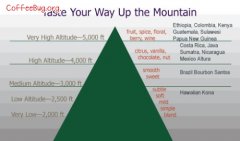Classification of coffee beans explanation of packaging names and specifications of coffee beans
The essentials of distinguishing coffee beans by ●
Recently, in response to the needs of customers' gourmatism, the number of unroasted raw coffee bean stores has been increasing all over the country. In the store, you can personally choose what you like from the raw coffee on display, and some stores can also bake it for you on the spot. In this way, you can taste the fried and fragrant coffee at home.
Here, I will introduce you to the coffee names and specifications that you should pay attention to when buying coffee beans.

Representation of names and specifications
Name of ● export port
The route of transportation can be known from the name of the port of exit marked. Coffee from the same origin or the same brand has a certain route, so it is also exported from the same port. For example, if it is marked "Brazil." Santos, however, indicates that this is coffee exported from Santos, with the exception of those marked "Mocha". Some Yemeni coffee, after leaving the port, still uses the port name of Mocha (Moka). In the motor). In addition, Ethiopian coffee is also known as "Haramoka".
● original species name, variety name
Only coffee produced in countries such as Arabia will be omitted, but if Arabica and Robusta seeds are shipped, they will be marked with the variety name under the country name. For example: "Camelon. Arabica, Uganda. Robusta and so on. In addition, there are signs of Mendonobo, Bloomeng and other variety names.
● Mountain name
Blue Mountain (Jamaica), Mount Jiayu (Indonesia), Mount Clarr (Costa Rica), Mount Kilimanjaro (Cuba), Mount Kilimanjaro (Tanzania), Mawendohagen (Papua New Guinea) are all famous brands.
● grade, specification
At present, each producing country has its own independent standards. The most commonly adopted criteria are as follows:
A: washing / non-washing
B: flat beans / round beans
C: filter screen (size of coffee beans)
Filter number Coffee Bean size
Pingdou 20-29 extra large
18 big
17 quasi-big
16 ordinary
15
14 small
13-12 extra small
Round beans 13-12
11 quasi-big
10 ordinary
9
8 small
Most countries, such as Brazil, Colombia, Tanzania and so on, adopt C classification. Although there may not be an absolute relationship between the size and quality of coffee beans, it can make the size of raw coffee beans the same.
According to the elevation of the cultivated land, it can be divided into three, four, seven and other grades (different national standards). For example, Mexico and Honduras adopt three grades, while Guatemala adopts seven grades. Generally speaking, the quality of highland beans is better than that of lowland beans, and the price is higher because of the increase in freight.
E: quality Typ
The type and quantity of blends (defective beans) contained in a certain amount of samples are converted into "defective number", and a certain sum is taken as the basis for determining the type of quality. Brazil, Ethiopia, Cuba, Peru and other countries all have benchmarks for the number of defects, and the smaller the value, the better.
F: set specifications according to taste
Brazil, Haiti, Kenya, Zaire and other countries all have their own taste testing methods, which can be exported only after taste testing.
Name of ● exporter
The name of the ship, export industry, etc., that exports coffee beans.
Check the raw coffee beans by hand
It is also very important to refer to the markings of origin and specifications and touch them directly with your hands to observe their appearance and feeling.
To judge the quality of raw coffee beans by their appearance, you must have a certain degree of experience, but as long as the type is certain, you will be able to handle it easily.
● color is spotless, light green and bright, for the beautiful color of coffee beans, which is also related to the harvest.
The ● shape uses coffee beans of the same size to avoid deformed beans and remove them even if there is a small amount of them.
● raw coffee beans have a unique bright green, which does not necessarily mean that they have a good taste, but can be proved to be fresh agricultural products. In addition to the original fragrance, it should also be noted that it may be contaminated with other peculiar smells (such as fermentation, mildew, medicinal smell, fishy smell, etc.).
● defective beans, such as moth-eaten coffee beans, immature, fermented, shell beans, chopped beans, etc., can be inspected by appearance.
The origin of ● coffee
Today, there are more than 100 varieties of coffee, but these more than 100 kinds of coffee are all derived from Arabica coffee, Robbda coffee and Liberian coffee, which come from different countries as follows:
Brazil
The largest coffee producer, which accounts for 1/3 of the world's coffee consumption, accounts for 1/3 of the world's coffee consumption and has a place in the global coffee market, although Brazil faces several times more natural disasters than other regions. but its acreage is enough to make up for it.
There are many kinds of coffee here, but its industrial policy is large and cheap, so there is not much premium coffee, but it is a good choice for mixing other coffees.
One of the most famous is Sandos Coffee, which tastes mellow and neutral. It can be boiled directly or mixed with other kinds of coffee beans to form a comprehensive coffee. It is also a good choice.
Other kinds of Brazilian coffee, such as Rio and Parana, can be produced in large quantities because they do not need too much care. Although the taste is rough, it is a kind of coffee with good quality and low price.
Colombia
This is the second largest coffee industry after Brazil, and is also the leader in the Columbia Maird Group (Colombia, Tanzania, Kenya). In addition, there are Asa Maird, Anwar Snow Arabica, Robsta). The more famous producing areas, such as "Medellin", "Manizarez", "Bogota" and "Armenia", all the coffee beans cultivated are Anicabi species, which are quite rich in taste and stable in quality and price. The fried coffee beans are even bigger and more beautiful.
From low-grade products to high-grade products can be produced, some of which are rare good goods in the world, the taste is so mellow that people can't put it down.
Mexico
This major coffee producer in Central America, the coffee here is comfortable and charming. The Mexican coffee selected are Coatepec, Huatusco and Orizaba, of which Cottpe is considered to be one of the best in the world.
Hawaii
To visit Hawaii, in addition to the beautiful beach, don't forget the Hawaiian coffee bean-Kona.
The palate is sweet with the acidity of a pleasant wine, very special. It is Kona, which is produced on the southwest coast of Hawaii, which is the most traditional and famous coffee in Hawaii.
However, because the production here is not high, the cost is surprisingly high, and the demand for individual coffee in the United States and other places is increasing, so its unit price is not only getting higher and higher, but also not easy to buy.
Indonesia
When it comes to Indonesian coffee, we must not miss the high-end Mantenin of Sumatra, which has a unique fragrant taste, slightly acidic taste and can be said to be the best in the world. In addition, Arabian coffee produced in Java is the favorite of Europeans, which is sweet in bitterness and sour in the middle of it, which lasts for a long time.
Costa Rica
The coffee beans produced at the high latitudes of Costa Rica are famous in the world, full-bodied, mild in taste, but extremely sour. The coffee beans here have been carefully processed, which is why they have high quality coffee.
The famous coffee is produced in the Central Plateau (Central Plateau), where the soil consists of successive layers of volcanic ash and dust.
Angola
This is the fourth largest coffee industry in the world, but it produces only a small amount of Arabian coffee, which is of high quality, but unfortunately, its annual output is extremely unstable due to its political upheaval.
Ethiopia
Arabian coffee is the hometown of Arabian coffee, which grows at high latitudes and needs a lot of manual care. Here is the famous Ethiopian mocha, which is sour, fragrant and productive similar to wine.
Unfortunately, some farmers still do not understand the benefits of picking fruit and allow them to fall behind and pick it up from the ground, but in recent years, due to the continuous expansion of the market, coffee industry is committed to improving harvesting and processing methods, hoping to increase production.
Jamaica
Jamaica's national treasure, Blue Mountain Coffee, is perfect in all respects, just like wine, many wineries are now bought by the Japanese.
The Japanese have bought most of the Jamaican coffee in recent years, so it is very difficult to buy it in the market. It is said that it has not been available in Britain for four years, and the spending power of Easterners is really staggering.
Kenya
Kenya grows high-quality Arabica coffee beans, which absorb almost the essence of coffee cherries, with a slightly sour, thick aroma, and are very popular among Europeans, especially in Britain. Kenya Coffee has surpassed Costa Rican coffee and become one of the most popular coffees.
Yemen
There was a whirlwind of mocha coffee in Yemen, which blew a whirlwind around the world, but unfortunately, the good times were not very good. Under the political turmoil and unplanned planting, the production of mocha was very unstable.
Having said that, mocha is still the soul of matching other coffee beans or mixed coffee beans.
Peru
Peruvian coffee, a rising star, is gradually opening up its popularity and entering the world. It is mostly planted in high-altitude areas, the planned planting makes the yield greatly increased, the taste mellow, the right acidity, more and more people like it.
Erdi Mara
The central region of Guatemala is home to world-famous coffee with excellent flavor. Most of the coffee beans here have charcoal flavor and cocoa flavor, but their acidity is slightly stronger.
Important Notice :
前街咖啡 FrontStreet Coffee has moved to new addredd:
FrontStreet Coffee Address: 315,Donghua East Road,GuangZhou
Tel:020 38364473
- Prev

The basic method of making espresso the steps of making coffee in a mocha pot
1) tools for espresso 1) mocha kettle group (including gas stove and stove) 2) coffee beans 3) bean grinder 4) pellet filter paper 5) espresso cup plate group 2) items for the use of mocha pots. It is recommended that you try to brew the coffee several times before tasting the coffee. two。 In order to prevent the coffee pot from being burned empty when brewing coffee, a small amount of water will be left in the pot after brewing coffee.
- Next

Relationship between altitude of Fine Coffee Bean planting and Coffee Flavor
The influence of geographical location on the flavor of coffee beans is profound. All coffee grows in the tropics, and the altitude at which it grows has a profound effect on the taste of coffee. The tropical belt extends from 30 degrees north latitude to the equatorial regions of the southern mountains that produce the world's truly high-quality Arabica coffee. Central and South America, South Asia and some Pacific islands, south-central Africa is also the most important in the world.
Related
- Detailed explanation of Jadeite planting Land in Panamanian Jadeite Manor introduction to the grading system of Jadeite competitive bidding, Red bid, Green bid and Rose Summer
- Story of Coffee planting in Brenka region of Costa Rica Stonehenge Manor anaerobic heavy honey treatment of flavor mouth
- What's on the barrel of Blue Mountain Coffee beans?
- Can American coffee also pull flowers? How to use hot American style to pull out a good-looking pattern?
- Can you make a cold extract with coffee beans? What is the right proportion for cold-extracted coffee formula?
- Indonesian PWN Gold Mandrine Coffee Origin Features Flavor How to Chong? Mandolin coffee is American.
- A brief introduction to the flavor characteristics of Brazilian yellow bourbon coffee beans
- What is the effect of different water quality on the flavor of cold-extracted coffee? What kind of water is best for brewing coffee?
- Why do you think of Rose Summer whenever you mention Panamanian coffee?
- Introduction to the characteristics of authentic blue mountain coffee bean producing areas? What is the CIB Coffee Authority in Jamaica?

